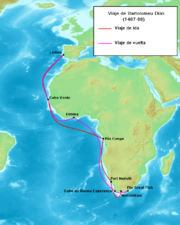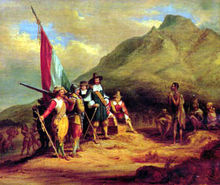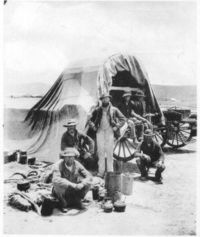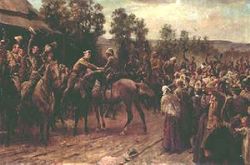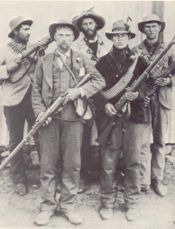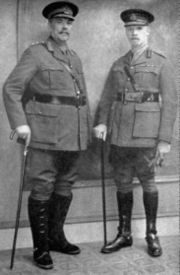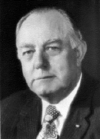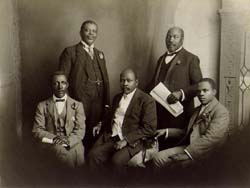History of South Africa
2007 Schools Wikipedia Selection. Related subjects: General history
|
|
| History of Cape Town |
| History of South Africa in the apartheid era |
| History of the Jews in South Africa |
| History of Cape Colony |
| Union of South Africa |
| Orange Free State |
| Truth and Reconciliation Commission |
| 1820 Settlers |
| King of South Africa |
| Governor-General of the Union of South Africa |
| Xhosa Wars |
| Ndwandwe-Zulu War |
| Anglo-Zulu War |
| First Boer War |
| Second Boer War |
| South Africa Act 1909 |
| Topics |
| Economic History |
| Military History |
| Social History |
The history of South Africa is viewed differently by various scholars and by its various population groups because South Africa is a multicultural country. The researchers' views heavily influence their perception of South African history.(See the demographics of South Africa and culture of South Africa.)
The Khoisan peoples are the aboriginal people of the region who have lived there for millennia. Black African South Africans, trace their origins to the Great Lakes region of Africa. Whites in South Africa, descendants of later European migrations, regard themselves as products of South Africa no less than their fellow citizens, as do South Africa's Coloureds, Indians, Asians and Jews.
Definitions: History and anthropology
There are two divergent ways in which information about the past can be conveyed: The definition of "history" means the study of the past based almost exclusively on written records because it is "usually distinguished from prehistory by the widespread adoption of writing in the area under study" (see History article.) Prehistory, as studied in anthropology, "is concerned with all institutions of all societies, but in practice anthropologists have tended to concentrate on the seemingly more "traditional" institutions, usages, and customs of non-Western, often tribal, societies" (see Anthropology article.)
Modern history of South Africa
European explorers "discovered" South Africa as a direct result of European countries' rivalry with each other for dominance and the subsequent need for wealth which lead to the efforts to "discover" (by exploration) sea routes to trade with Asia and the Far East during the Age of Discovery. Far-off places, whether they became colonies or not, were regarded as sources for raw materials to be processed or enjoyed by Europeans.
Over time, for example, be it jewels, spices and textiles from India, foods and silver from the Americas; wool from Australia; fruits, gold, diamonds, coal, uranium, or iron from South Africa; wood and minerals from Africa - obtained as the result of voyages of discovery, these resources were located and shipped in huge quantities to Europe over the centuries, generating immense wealth in helping countries to move to become even more sophisticated as they developed into newly industrialized countries like Great Britain, Germany and France. In the 1800s South Africa would become the world's leading producer of gold and diamonds as well as many other resources, which made it the envy and the play-thing of stronger imperial powers to the North.
Once the route around the Cape of Good Hope, located at the southern-most tip of Africa in South Africa, had been discovered by a series of "discoverers" it has remained of key importance to global trade that is dependent on the free passage of ships around the world. This is related to another principle, that wealthy nations are usually great maritime naval powers, and the use of navies is tied in with protecting those great nations' trade and their military strength both of which result in geostrategic dominance. Essentially, the power that has the mightiest navy and prevails on the high seas becomes the world's greatest power which is something nations have known for a long time, hence their commercial and naval rivalry on the high seas.
It is in this context that the position of the Cape of Good Hope, South Africa, and Southern Africa should be appreciated because in the Southern Hemisphere, only South Africa, the southern end of South America, and Australia have this key strategic position. In addition, from Europe - and also from the east coasts of the United States and South America (Brazil, Argentina), the route around South Africa's Cape is the shortest to Asia.
All the modern natives have sought to ensure that they either control these three southern "gateways" or that they remain open at all times to the free flow of shipping and it is why South Africa's strategic position is important in a geopolitical sense. It is the reason that the British knocked out the Spanish, Portuguese, Dutch, and French navies and influence not just in Southern Africa, but all over the world, and asserted their will and continued this policy against Germany, Italy, Japan and Russia. Since World War II it has been the United States Navy that has assumed the role of the world's most dominant fleet protecting America' trade and the free flow of goods in the global economy and South Africa's place in this scheme of things is no less significant than it was in the times of the Dutch who established South Africa's early economy and the British who developed it into a more sophisticated modern one.
It should be noted that the Suez Canal did not exist for most of history. It was only completed in 1869, so that all shipping back and forth from Europe to Asia, Arabia, and to most of Africa had and has to be done by the long routes across the seas around South Africa's Cape. In addition, even after the Suez Canal's completion and modernization, it cannot accommodate larger vessels including many warships, tankers, and cargo vessels. Thus the Cape of Good Hope route remains one of the most important and highly desirable routes for free shipping when some of the world's other global choke points are closed off or in a state of turmoil such as war.
The Portuguese, the first Europeans to reach and land in South Africa, chose not to colonise the areas of present-day South Africa, instead they colonized Portuguese Guinea (present-day Guinea-Bissau) starting in 1446, Angola starting in 1483, Mozambique starting in 1498, and other colonies in the world.
It had been Portugal in the Age of Discovery that sent Bartolomeu Dias sailing southwards in the Atlantic Ocean (in those days sailing ship tried to stay close to the coast of Western Africa as they did so) looking for a route to India. Dias sailed around the Cape of Good Hope, the southern tip of Africa into the Southern Indian Ocean, in 1488, the first European known to do so since ancient times.
It should be noted that this is four years before another explorer by the name of Christopher Columbus set sail from rival Spain in order to find an even shorter route to India, but instead as he kept on sailing due West across the Northern Atlantic Ocean, he "discovered" America in 1492 -- and hence the Native Americans were called by the name of "Indians" mistaking them for the people of India. Dias did not settle in South Africa but took back a report that the Cape could be rounded. It was Vasco da Gama who was the first person to sail directly from Europe to India during 1497- 1499.

Southern Africa was viewed as too dangerous and inhospitable for European sailors, let alone settlers. The Cape was known as "The Cape of Storms" because it was so dangerous for sailing ships, and it was only by 1652 that the Dutch finally saw fit to set up a permanent station at the Cape of Good Hope (it was not even a colony, just a station to supply passing ships with fresh water and vegetables.) This "supply depot" that was set up by the Dutch developed into the Cape Colony over the next two hundred years.
The British had long known about the importance of the Cape as a route to and from the East and had their eyes on it from the time that one of their own explorers, Sir Francis Drake rounded the Cape of Good Hope, in 1580 in his ship the Golden Hind. Drake was so enchanted by Table Mountain in the bay of what is today Cape Town, that he is reputed to have declared, that "No longer shall this be called the Cape of Storms, for it is the fairest Cape of them all."

The British seized the Cape Colony from the Dutch at the end of the 18th century because they feared French fleets would take control following Napoleon's victories over much of mainland Europe. The United Kingdom invaded and occupied the Cape Colony in 1795 ("The First Occupation") but relinquished control of the territory in 1803. However, British forces returned on January 19, 1806 and occupied the Cape once again ("The Second Occupation"). The territory was ceded to the UK in the Anglo-Dutch Treaty of 1814 and was henceforth administered as the Cape Colony. It remained a British colony until incorporated into the independent Union of South Africa in 1910, now known as the Republic of South Africa.
The ever-expanding number of European settlers led to conflicts with the natives over the rights to land and farming, which caused numerous fatalities on both sides. Hostilities also emerged between the Dutch and the British, and many Dutch people packed up their ox-wagons and trekked into the central Highveld in order to establish their own self-governing colonies.
The Dutch (by then known as Boers) and the British went to war twice in the Anglo-Boer Wars in the late 1800s, which ended in the defeat of the Boers and of their independent republics.
The Cape Colony, Natal and the two Boer republics united in 1910 as the Union of South Africa. The Boer republics did not grant Black people the suffrage, and the rights of Black, Coloured, and Asian people continued to erode in the Union.
The National Party came to power ( 1948), on a platform of racial discrimination which became known as apartheid. As a rising tide of national liberation grew in the Third World receiving support, arms, and training from the newly dominant Soviet Union and the People's Republic of China, South Africa's Blacks demanded freedom and political rights that white South Africa had not granted them. Instead, the Afrikaner-dominated government answered with increased Apartheid policies which then became deeply entrenched in South African society, despite continued resistance.
When Commonwealth nations began to threaten South Africa with economic and political sanctions, white South Africa headed by Prime Minister HF Verwoerd decided to leave the commonwealth, and chose to become a republic in 1961, with its own State President CR Swart. This was the first that there was a South African president in sixty years, since the days of the old Transvaal South African Republic when President Paul Kruger was exiled by the British in 1900.
The African National Congress offered the most active black-run opposition to apartheid, and after two decades of repression and increasing economic pressures, the government of F.W. de Klerk dismantled the apartheid system in 1992. The first fully-inclusive election, in which blacks from the entire South Africa could vote, took place in 1994, electing Nelson Mandela as President. South Africa now sees itself as a multiracial democracy.
Pre-historic anthropology of South Africa
Ape-like hominids who migrated to South Africa around 3 million years ago became the first human-like inhabitants of the area now known as South Africa. Representatives of homo erectus gradually replaced them around a million years ago when they also spread across Africa and into Europe and Asia. Homo erectus gave way to homo sapiens around 100,000 years ago. The first homo sapiens formed the Bushman culture of skilled hunter-gatherers.
South Africa prior to the emergence of modern humans (Homo sapiens) remains shrouded in mystery. A major archaeological find in 1998 at Sterkfontein near Johannesburg revealed that hominids roamed across the Highveld at least three million years ago. About a million years ago, Homo erectus had emerged and ranged well beyond Africa, leaving traces in Europe and in Asia. Somewhere around 100,000 years ago, modern man replaced the hominids. Although archaeologists continue to debate the details, fossils found near the mouth of the Klasies River in Eastern Cape Province indicate that Homo sapiens may have lived in South Africa as early as 90,000 years ago.
The Bushmen probably became the first modern people to migrate to the southern tip of the African continent. Skilled hunter-gatherers and nomads, the Bushmen had great respect for the land, and their lifestyle had low environmental impact, allowing them to sustain their way of life for years without leaving much archaeological evidence. Other than a series of striking rock paintings, the Bushmen left few traces of their early culture. Attempts to analyse the existing samples by radiocarbon dating indicate that the Bushmen lived in the area of modern-day South Africa at least as early as 25,000 years ago, and possibly as early as 40,000 years ago. Small numbers of Bushmen still live in South Africa today, making their culture one of the oldest continuously existing in the world, along with that of the Indigenous Australians.
Ancient history
Around 2,500 years ago Bantu peoples migrated into Southern Africa from the Niger River Delta. The Bushmen and the Bantu lived mostly peacefully together, although since neither had any method of writing, researchers know little of this period outside of archaeological artefacts.
Beginning around 2,500 years ago, some Bushman groups acquired livestock from further north. Gradually, hunting and gathering gave way to herding as the dominant economic activity as the Bushmen tended to small herds of cattle and oxen. The arrival of livestock introduced concepts of personal wealth and property- ownership into Bushman society. Community structures solidified and expanded, and chieftaincies developed.
The pastoralist Bushmen, known as Khoikhoi ("men of men"), began to move further south, reaching as far as the cape now known as the Cape of Good Hope. Along the way they intermarried with the hunter-gatherer Bushmen, whom they referred to as San, to the point where drawing a clear line between the two groups became impossible (prompting the use of the term Khoisan). Over time the Khoikhoi established themselves along the coast, while small groups of Bushmen continued to inhabit the interior.
Bantu expansion
At about this time, Bantu-speaking peoples also began arriving in South Africa. Originally from the Niger Delta area in west Africa, they had started to make their way south and eastwards in about 1000 BC, reaching present-day KwaZulu-Natal Province by 500 AD. The Bantu-speakers not only had domestic animals, but also practised agriculture, farming wheat and other crops. They also displayed skill in working iron, and lived in settled villages. The Bantu arrived in South Africa in small waves rather than in one cohesive migration. Some groups, the ancestors of today's Nguni peoples (the Zulu, Xhosa, Swazi, and Ndebele), preferred to live near the coast. Others, now known as the Sotho-Tswana peoples ( Tswana, Pedi, and Basotho), settled in the Highveld, while today's Venda, Lemba, and Shangaan- Tsonga peoples made their homes in the northeastern areas of South Africa.
Bantu-speakers and Khoisan mixed, as evidenced by rock paintings showing the two different groups interacting. The type of contact remains unknown, although linguistic proof of integration survives, as several Bantu languages (notably Xhosa and Zulu) incorporated the click consonant characteristic of earlier Khoisan languages. Archaeologists have found numerous Khoisan artifacts at the sites of Bantu settlements.
Colonization
European expeditions
Although the Portuguese basked in the nautical achievement of successfully navigating the cape, they showed little interest in colonization. The area's fierce weather and rocky shoreline posed a threat to their ships, and many of their attempts to trade with the local Khoikhoi ended in conflict. The Portuguese found the Mozambican coast more attractive, with appealing bays to use as waystations, prawns, and links with gold ore in the interior.
The Portuguese had little competition in the region until the late 16th century, when the English and Dutch began to challenge them along their trade routes. Stops at the continent's southern tip increased, and the cape became a regular stopover for scurvy-ridden crews. In 1647, a Dutch vessel got wrecked in the present-day Table Bay at Cape Town. The marooned crew, the first Europeans to attempt settlement in the area, built a fort and stayed for a year until they were rescued. Shortly thereafter, the Dutch East India Company (in the Dutch of the day: Vereenigde Oostindische Compagnie, or VOC) decided to establish a permanent settlement. The VOC, one of the major European trading houses sailing the spice route to the East, had no intent of colonizing the area, but only wanted to establish a secure base camp where passing ships could shelter, and where hungry sailors could stock up on fresh supplies of meat, fruit, and vegetables. To this end, a small VOC expedition under the command of Jan van Riebeeck reached Table Bay on April 6, 1652.
Arrival of the Dutch
While the new settlement traded out of necessity with the neighbouring Khoikhoi, one could hardly describe the relationship as friendly, and the authorities made deliberate attempts to restrict contact. Partly as a consequence, VOC employees found themselves faced with a labour shortage. To remedy this, they released a small number of Dutch from their contracts and permitted them to establish farms, with which they would supply the VOC settlement from their harvests. This arrangement proved highly successful, producing abundant supplies of fruit, vegetables, wheat, and wine; they later raised livestock. The small initial group of free burghers, as these farmers were known, steadily increased and began to expand their farms further north and east into the territory of the Khoikhoi.
The majority of burghers had Dutch ancestry and belonged to the Calvinist Reformed Church of the Netherlands, but there were also numerous Germans as well as some Scandinavians. In 1688 the Dutch and the Germans were joined by the French Huguenots, also Calvinists, who were fleeing religious persecution under King Louis XIV.
In addition to establishing the free burgher system, van Riebeeck and the VOC also began to import large numbers of slaves, primarily from Madagascar and Indonesia. These slaves often married Dutch settlers, and their descendants became known as the Cape Coloureds and the Cape Malays. A significant number of the offspring from the White and slave unions were absorbed into the local proto Afrikaans speaking White population. With this additional labour, the areas occupied by the VOC expanded further to the north and east, with inevitable clashes with the Khoikhoi. The newcomers drove the beleaguered Khoikhoi from their traditional lands, decimated them with introduced diseases, and destroyed them with superior weapons when they fought back, which they did in a number of major wars and with guerrilla resistance movements which continued into the 19th century. Most survivors were left with no option but to work for the Europeans in an exploitative arrangement that differed little from slavery. Over time, the Khoisan, their European overseers, and the imported slaves mixed, with the offspring of these unions forming the basis for today's Coloured population.
The best-known Khoikhoi groups included the Griqua, who had originally lived on the western coast between St Helena Bay and the Cederberg Range. In the late 18th century, they managed to acquire guns and horses and began trekking northeast. En route other groups of Khoisan, Coloureds, and even white adventurers joined them, and they rapidly gained a reputation as a formidable military force. Ultimately, the Griquas reached the Highveld around present-day Kimberley, where they carved out territory that came to be known as Griqualand.
Burgher expansion
As the burghers, too, continued to expand into the rugged hinterlands of the north and east, many began to take up a semi-nomadic pastoralist lifestyle, in some ways not far removed from that of the Khoikhoi they displaced. In addition to its herds, a family might have a wagon, a tent, a Bible, and a few guns. As they became more settled, they would build a mud-walled cottage, frequently located, by choice, days of travel from the nearest European. These were the first of the Trekboers (Wandering Farmers, later shortened to Boers), completely independent of official controls, extraordinarily self-sufficient, and isolated. Their harsh lifestyle produced courageous individualists, who knew the veld and nature intimately, and based their lives on their main source of guidance, the Bible.
The British at the Cape
As the 18th century drew to a close, Dutch mercantile power began to fade, and the British moved in to fill the vacuum. They seized the Cape in 1795 to prevent it from falling into rival French hands, then briefly relinquished it back to the Dutch (1803) before finally garnering recognition of their sovereignty of the area in 1814.
At the tip of the continent the British found an established colony with 25,000 slaves, 20,000 white colonists, 15,000 Khoisan, and 1,000 freed black slaves. Power resided solely with a white élite in Cape Town, and differentiation on the basis of race was deeply entrenched. Outside Cape Town and the immediate hinterland, isolated black and white pastoralists populated the country.
Like the Dutch before them, the British initially had little interest in the Cape Colony, other than as a strategically located port. As one of their first tasks they tried to resolve a troublesome border dispute between the Boers and the Xhosa on the colony's eastern frontier. In 1820 the British authorities persuaded about 5,000 middle-class British immigrants (most of them "in trade") to leave England behind and settle on tracts of land between the feuding groups with the idea of providing a buffer zone. The plan was singularly unsuccessful. Within three years, almost half of these 1820 Settlers had retreated to the towns, notably Grahamstown and Port Elizabeth, to pursue the jobs they had held in Britain.
While doing nothing to resolve the border dispute, this influx of settlers solidified the British presence in the area, thus fracturing the relative unity of white South Africa. Where the Boers and their ideas had before gone largely unchallenged, European Southern Africa now had two language groups and two cultures. A pattern soon emerged whereby English-speakers became highly urbanised, and dominated politics, trade, finance, mining, and manufacturing, while the largely uneducated Boers were relegated to their farms.
The gap between the British settlers and the Boers further widened with the abolition of slavery in 1833, a move that the Boers generally regarded as against the God-given ordering of the races. Yet, the British settlers' conservatism and sense of racial superiority stopped any radical social reforms, and in 1841 the authorities passed a Masters and Servants Ordinance, which perpetuated white control. Meanwhile, British numbers increased rapidly in Cape Town, in the area east of the Cape Colony (present-day Eastern Cape Province), in Natal and, after the discovery of gold and diamonds, in parts of the Transvaal, mainly around present-day Gauteng.
Difaqane and destruction
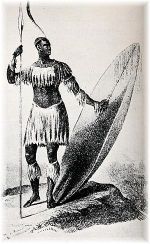
The early 19th century saw a time of immense upheaval relating to the military expansion of the Zulu kingdom. Sotho-speakers know this period as the difaqane (" forced migration"); while Zulu-speakers call it the mfecane ("crushing").
The full causes of the difaqane remain in dispute, although certain factors stand out. The rise of a unified Zulu kingdom had particular significance. In the early 19th century, Nguni tribes in KwaZulu-Natal began to shift from a loosely-organised collection of kingdoms into a centralised, militaristic state. Shaka Zulu, son of the chief of the small Zulu clan, became the driving force behind this shift. At first something of an outcast, Shaka proved himself in battle and gradually succeeded in consolidating power in his own hands. He built large armies, breaking from clan tradition by placing the armies under the control of his own officers rather than of the hereditary chiefs. Shaka then set out on a massive programme of expansion, killing or enslaving those who resisted in the territories he conquered. His impis (warrior regiments) were rigorously disciplined: failure in battle meant death.
Peoples in the path of Shaka's armies moved out of his way, becoming in their turn aggressors against their neighbours. This wave of displacement spread throughout Southern Africa and beyond. It also accelerated the formation of several states, notably those of the Sotho (present-day Lesotho) and of the Swazi (now Swaziland).
In 1828 Shaka was killed by his half-brothers Dingaan and Umthlangana. The weaker and less-skilled Dingaan became king, relaxing military discipline while continuing the despotism. Dingaan also attempted to establish relations with the British traders on the Natal coast, but events had started to unfold that would see the demise of Zulu independence.
The Great Trek
Meanwhile, the Boers had started to grow increasingly dissatisfied with British rule in the Cape Colony. The British proclamation of the equality of the races particularly angered them. Beginning in 1835, several groups of Boers, together with large numbers of Khoikhoi and black servants, decided to trek off into the interior in search of greater independence. North and east of the Orange River (which formed the Cape Colony's frontier) these Boers or Voortrekkers (" Pioneers") found vast tracts of apparently uninhabited grazing lands. They had, it seemed, entered their promised land, with space enough for their cattle to graze and their culture of anti-urban independence to flourish. Little did they know that what they found — deserted pasture lands, disorganised bands of refugees, and tales of brutality — resulted from the difaqane, rather than representing the normal state of affairs.
With the exception of the more powerful Ndebele, the Voortrekkers encountered little resistance among the scattered peoples of the plains. The difaqane had dispersed them, and the remnants lacked horses and firearms. Their weakened condition also solidified the Boers' belief that European occupation meant the coming of civilisation to a savage land. However, the mountains where King Moshoeshoe I had started to forge the Basotho nation that would later become Lesotho and the wooded valleys of Zululand proved a more difficult proposition. Here the Boers met strong resistance, and their incursions set off a series of skirmishes, squabbles, and flimsy treaties that would litter the next 50 years of increasing white domination.
British vs. Boers vs. Zulus

The Great Trek first halted at Thaba Nchu, near present-day Bloemfontein, where the trekkers established a republic. Following disagreements among their leadership, the various Voortrekker groups split apart. While some headed north, most crossed the Drakensberg into Natal with the idea of establishing a republic there. Since the Zulus controlled this territory, the Voortrekker leader Piet Retief paid a visit to King Dingaan: the suspicious Zulu promptly killed him. This massacre triggered others, as well as a revenge attack by the Boers. The culmination came on 16 December 1838, in the Battle of Blood River, fought at the Ncome River in Natal. Though several Boers suffered injuries, they killed several thousand Zulus, reportedly causing the Ncome's waters to run red.
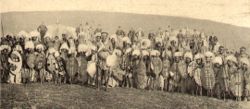
After this victory, which resulted from the possession of superior weapons, the Boers felt that their expansion really did have a long-suspected stamp of divine approval. Yet their hopes for establishing a Natal republic remained short-lived. The British annexed the area in 1843, and founded their new Natal colony at present-day Durban. Most of the Boers, feeling increasingly squeezed between the British on one side and the African populations on the other, headed north, adding yet another grievance against the British.
The British set about establishing large sugar- plantations in Natal, but found few inhabitants of the neighbouring Zulu areas willing to provide labour. The British confronted stiff resistance to their encroachments from the Zulus, a nation with well-established traditions of waging war, who inflicted one of the most humiliating defeats on the British army at the Battle of Isandlwana in 1879 when it killed over 1400 British soldiers. In ongoing Anglo-Zulu Wars, the British eventually established their control over then-named Zululand in large areas of present-day Natal.
The British turned to India to resolve their labour shortage, as Zulu men refused to adopt the servile position of laborers and in 1860 the SS Truro arrived in Durban harbour with over 300 people on board. Over the next 50 years, 150,000 more indentured Indians arrived, as well as numerous free "passenger Indians", building the base for what would become the largest Indian community outside of India. As early as 1893, when Mahatma Gandhi arrived in Durban, Indians outnumbered whites in Natal. (See Asians in South Africa.)
Growth of independent South Africa
The Boer republics

The Boers meanwhile persevered with their search for land and freedom, ultimately establishing themselves in the Transvaal and in the Orange Free State. For a while it seemed that these republics would develop into stable states, despite having thinly-spread populations of fiercely independent Boers, no industry, and minimal agriculture. Then the discovery of diamonds near Kimberley turned the Boers' world on its head ( 1869). The first diamonds came from land belonging to the Griqua, but to which both the Transvaal and Orange Free State laid claim. Britain quickly stepped in and resolved the issue by annexing the area for itself.
The discovery of the Kimberley diamond-mines unleashed a flood of European and black labourers into the area. Towns sprang up in which the inhabitants ignored the "proper" separation of whites and blacks, and the Boers expressed anger that their impoverished republics had missed out on the economic benefits of the mines.
The Anglo-Boer Wars
First Anglo-Boer War
Long-standing Boer resentment turned into full-blown rebellion in the Transvaal (under British control from 1877), and the first Anglo-Boer War, known to Afrikaners as the "War of Independence", broke out in 1880. The conflict ended almost as soon as it began with a crushing Boer victory at Battle of Majuba Hill ( 27 February 1881). The republic regained its independence as the Zuid-Afrikaansche Republiek (" South African Republic"), or ZAR. Paul Kruger, one of the leaders of the uprising, became President of the ZAR in 1883. Meanwhile, the British, who viewed their defeat at Majuba as an aberration, forged ahead with their desire to federate the Southern African colonies and republics. They saw this as the best way to come to terms with the fact of a white Afrikaner majority, as well as to promote their larger strategic interests in the area.
Inter-war period
In 1879, Zululand came under British control. Then in 1886, an Australian prospector discovered gold in the Witwatersrand, accelerating the federation process and dealing the Boers yet another blow. Johannesburg's population exploded to about 100,000 by the mid- 1890s, and the ZAR suddenly found itself hosting thousands of uitlanders, both black and white, with the Boers squeezed to the sidelines. The influx of Black labour in particular worried the Boers, many of whom suffered economic hardship and resented the black wage-earners.
The enormous wealth of the mines, largely controlled by European " Randlords", soon became irresistible for British imperialists. In 1895, a group of renegades led by Captain Leander Starr Jameson entered the ZAR with the intention of sparking an uprising on the Witwatersrand and installing a British administration. This incursion became known as the Jameson Raid. The scheme ended in fiasco, but it seemed obvious to Kruger that it had at least the tacit approval of the Cape Colony government, and that his republic faced danger. He reacted by forming an alliance with Orange Free State.
Second Anglo-Boer War
The situation peaked in 1899, when the British demanded voting rights for the 60,000 foreign whites on the Witwatersrand. Until that point, Kruger's government had excluded all foreigners from the franchise. Kruger rejected the British demand and called for the withdrawal of British troops from the ZAR's borders. When the British refused, Kruger declared war. This Second Anglo-Boer War lasted longer, and the British preparedness surpassed that of Majuba Hill. By June 1900, Pretoria, the last of the major Boer towns, had surrendered. Yet resistance by Boer bittereinders continued for two more years with guerrilla-style battles, which the British met in turn with scorched earth tactics. By 1902 26,000 Boers had died of disease and neglect in concentration camps. On 31 May 1902 a superficial peace came with the signing of the Treaty of Vereeniging. Under its terms, the Boer republics acknowledged British sovereignty, while the British in turn committed themselves to reconstruction of the areas under their control.
Roots of union
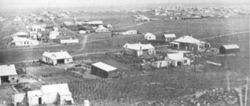
During the immediate post-war years the British focussed their attention on rebuilding the country, in particular the mining industry. By 1907 the mines of the Witwatersrand produced almost one-third of the world's annual gold production. But the peace brought by the treaty remained fragile and challenged on all sides. The Afrikaners found themselves in the ignominious position of poor farmers in a country where big mining ventures and foreign capital rendered them irrelevant. Britain's unsuccessful attempts to anglicise them, and to impose English as the official language in schools and the workplace particularly incensed them. Partly as a backlash to this, the Boers came to see Afrikaans as the volkstaal ("people's language") and as a symbol of Afrikaner nationhood. Several nationalist organisations sprang up.
The system left Blacks and Coloureds completely marginalised. The authorities imposed harsh taxes and reduced wages, while the British caretaker administrator encouraged the immigration of thousands of Chinese to undercut any resistance. Resentment exploded in the Bambatha Rebellion of 1906, in which 4,000 Zulus lost their lives after protesting against onerous tax legislation.
The British meanwhile moved ahead with their plans for union. After several years of negotiations, the South Africa Act 1909 brought the colonies and republics — Cape Colony, Natal, Transvaal, and Orange Free State — together as the Union of South Africa. Under the provisions of the act, the Union remained British territory, but with home-rule for Afrikaners. The British High Commission territories of Basutoland (now Lesotho), Bechuanaland (now Botswana), Swaziland, and Rhodesia (now Zambia and Zimbabwe) continued under direct rule from Britain.
English and Dutch became the official languages. Afrikaans did not gain recognition as an official language until 1925. Despite a major campaign by Blacks and Coloureds, the voter franchise remained as in the pre-Union republics and colonies, and only whites could gain election to parliament.
1910 Union of South Africa
In 1910 the Union of South Africa was created by the unification of four areas, by joining the two former independent Boer republics of the South African Republic (Zuid-Afrikaansche Republiek) and the Orange Free State (Oranje Vrystaat) with the the British dominated Cape Province and Natal. Most significantly, the new Union of South Africa gained international respect with British Dominion status putting it on par with three other important British dominions and allies: Canada, Australia, and New Zealand.
World War I
Bonds with the British Empire
The Union of South Africa tied closely to the British Empire, automatically joined Great Britain and the allies against the German Empire. Both Prime Minister Louis Botha and Defence Minister Jan Smuts, both former Second Boer War generals who had fought against the British then, but who now became active and respected members of the Imperial War Cabinet. (See Jan Smuts during World War I.)
South Africa was part of significant military operations against Germany. In spite of Boer resistance at home, the Afrikaner-led government of Louis Botha unhestitatingly joined the side of the Allies of World War I and fought alongside its armies. The South African Government agreed to the withdrawal of British Army units so that they were free to join the European war, and laid plans to invade German South-West Africa. Elements of the South African army refused to fight against the Germans and along with other opponents of the Government rose in open revolt. The government declared martial law on 14 October 1914, and forces loyal to the government under the command of General Louis Botha and Jan Smuts proceeded to destroy the Maritz Rebellion. The leading Boer rebels got off lightly with terms of imprisonment of six and seven years and heavy fines. (See World War I and the Maritz Rebellion.)
Military action against Germany during World War I
The South African Union Defence Force saw action in a number areas:
- It dispatched its army to German South-West Africa (later known as South West Africa) and now known as Namibia. The South Africans expelled German forces and gained control of the former German colony. (See German South-West Africa in World War I.)
- A military expedition under General Jan Smuts was dispatched to German East Africa (later known as Tanganyika) and now known as Tanzania. The objective was to fight German forces in that colony and to try to capture the elusive German General von Lettow-Vorbeck. Ultimately, Lettow-Vorbeck fought his tiny force out of German East Africa into Mozambique, where he surrendered a few weeks after the end of the war. (See German East Africa in First World War.)
- 1st South African Brigade troops were shipped to France to fight on the Western Front. The most costly battle that the South African forces on the Western Front fought in was the Battle of Delville Wood in 1916. (See South African Army in World War I.)
- South Africans also saw action with the Cape Corps as part of the Egyptian Expeditionary Force in Palestine. (See Cape Corps 1915 - 1991)
Military contributions and casualties in World War I
More than 146,000 whites, 83,000 blacks and 2,500 people of mixed race (" Coloureds") and Asians served in South African military units during the war, including 43,000 in German South-West Africa and 30,000 on the Western Front. An estimated 3,000 South Africans also joined the Royal Flying Corps. The total South African casualties during the war was about 18,600 with over 12,452 killed - more than 4,600 in the European theatre alone.

There is no question that South Africa greatly assisted the Allies, and Great Britain in particular, in capturing the two German colonies of German-West-Africa and German-East-Africa as well as in battles in Western Europe and the Middle East. South Africa's ports and harbors, such as at Cape Town, Durban, and Simon's Town, were also important rest-stops, refueling-stations, and served as strategic assets to the British Royal Navy during the war, helping to keep the vital sea lanes to the British Raj open.
World War II
Political choices at outbreak of war
On the eve of World War II the Union of South Africa found itself in a unique political and military quandary. While it was closely allied with Great Britain, being a co-equal Dominion under the 1931 Statute of Westminster with its head of state being the British king, the South African Prime Minister on September 1, 1939 was none other than Barry Hertzog the leader of the pro-Afrikaner anti-British National party that had joined in a unity government as the United Party.
Herzog's problem was that South Africa was constitutionally obligated to support Great Britain against Nazi Germany. The Polish-British Common Defence Pact obligated Britain, and in turn its dominions, to help Poland if attacked by the Nazis. After Hitler's forces attacked Poland on the night of August 31, 1939, Britain declared war on Germany within a few days. A short but furious debate unfolded in South Africa, especially in the halls of power in the Parliament of South Africa, that pitted those who sought to enter the war on Britain's side, led by the pro- Allied pro-British Afrikaner and former Prime Minister Jan Smuts and General against then-current Prime Minister Barry Hertzog who wished to keep South Africa "neutral", if not pro- Axis.
Declaration of war against the Axis
On September 4, 1939, the United Party caucus refused to accept Hertzog's stance of neutrality in World War II and deposed him in favour of Smuts. Upon becoming Prime Minister of South Africa, Smuts declared South Africa officially at war with Germany and the Axis. Smuts immediately set about fortifying South Africa against any possible German sea invasion because of South Africa's global strategic importance controlling the long sea route around the Cape of Good Hope.
Smuts took severe action against the pro-Nazi South African Ossewabrandwag movement (they were caught committing acts of sabotage) and jailed its leaders for the duration of the war. (One of them, John Vorster, was to become future Prime Minister of South Africa.) (See Jan Smuts during World War II.)
Prime Minister and Field Marshal Smuts
Prime Minister Jan Smuts was the only important non-British general whose advice was constantly sought by Britain's war-time Prime Minister Winston Churchill. Smuts was invited to the Imperial War Cabinet in 1939 as the most senior South African in favour of war. In 28 May 1941, Smuts was appointed a Field Marshal of the British Army, becoming the first South African to hold that rank. Ultimately, Smuts would pay a steep political price for his closeness to the British establishment, to the King, and to Churchill which had made Smuts very unpopular among the conservative nationalistic Afrikaners, leading to his eventual downfall, whereas most English-speaking whites and a minority of liberal Afrikaners in South Africa remained loyal to him. (See Jan Smuts during World War II.)
Military contributions and casualties in World War II
South Africa and its military forces contributed in many theaters of war. South Africa's contribution consisted mainly of supplying troops, men and material for the North African campaign (the Desert War) and the Italian Campaign as well as to Allied ships that docked at its crucial ports adjoining the Atlantic Ocean and Indian Ocean that converge at the tip of Southern Africa. Numerous volunteers also flew for the Royal Air Force. (See: South African Army in World War II; South African Air Force in World War II; South African Navy in World War II.)
- The South African Army and Air Force helped defeat the Italian army of the Fascist Benito Mussolini that had invaded Abyssinia (now known as Ethiopia) in 1935. During the 1941 East African Campaign South African forces made important contribution to this early Allied victory.
- Another important victory that the South African's participated in was the liberation of Malagasy (now known as Madagascar) from the control of the Vichy French who were allies of the Nazis. British troops aided by South African soldiers, staged their attack from South Africa, occupied the strategic island in 1942 to preclude its seizure by the Japanese.
- The South African 1st Infantry Division took part in several actions in North Africa in 1941 and 1942, including the Battle of El Alamein, before being withdrawn to South Africa.
- The South African 2nd Infantry Division also took part in a number of actions in North Africa during 1942, but on 21 June 1942 two complete infantry brigades of the division as well as most of the supporting units were captured at the fall of Tobruk.
- The South African 3rd Infantry Division never took an active part in any battles but instead organised and trained the South African home defence forces, performed garrison duties and supplied replacements for the South African 1st Infantry Division and the South African 2nd Infantry Division. However, one of this division's constituent brigades - 7 SA Motorised Brigade - did take part in the invasion of Madagascar in 1942.
- The South African 6th Armoured Division fought in numerous actions in Italy from 1944 to 1945.
- South Africa contributed to the war effort against Japan, supplying men and manning ships in naval engagements against the Japanese.
Of the 334,000 men volunteered for full time service in the South African Army during the war (including some 211,000 whites, 77,000 blacks and 46,000 "coloureds" and Asians), nearly 9,000 were killed in action.
Aftermath of World War II
South Africa emerged from the Allied victory with its prestige and national honor enhanced as it had fought tirelessly for the Western Allies. South Africa's standing in the international community was rising, at a time when the Third World's struggle against colonialism had still not taken centre stage. In May 1945, Prime Minister Smuts represented South Africa in San Francisco at the drafting of the United Nations Charter. Just as he did in 1919, Smuts urged the delegates to create a powerful international body to preserve peace; he was determined that, unlike the League of Nations, the United Nations would have teeth. Smuts signed the Paris Peace Treaty, resolving the peace in Europe, thus becoming the only signatory of both the treaty ending the First World War, and that ending the Second.
However, internal political struggles in the disgruntled and essentially impoverished Afrikaner community would soon come to the fore leading to Smuts' defeat at the polls in the 1948 elections (in which only whites and coloroureds could vote) at the hands of a resurgent National Party after the war. This began the road to South Africa's eventual isolation from a world that would no longer tolerate any forms of political discrimination or differentiation based on race only.
General elections and the slow evolution of democracy
From 1910 until the present time, a series of important general elections have been held in a united South Africa. From 1910 until 1948 the franchise to vote was given to whites and to Cape Coloreds (people of mixed race) only. After the ascent of the Nationalist Party in 1948, the Cape Coloreds were taken off the voters' role. Only eligible whites were permited to vote from 1948 until 1994 when the vote was granted to South Africans of every racial group. The 1994 general election was the first post-apartheid vote based on universal suffrage.
There have been three referendums in South Africa: 1960 referendum on becoming a republic; 1983 referendum on implementing the tricameral parliament; and 1992 referendum on becoming a multiracial democracy all of which were held during the era of Nationalist Party control.
Apartheid era
Afrikaner nationalism
General Louis Botha headed the first government of the new Union, with General Jan Smuts as his deputy. Their South African National Party, later known as the South African Party or SAP, followed a generally pro-British, white-unity line. The more radical Boers split away under the leadership of General Barry Hertzog, forming the National Party (NP) in 1914. The NP championed Afrikaner interests, advocating separate development for the two white groups and independence from Britain.
The new Union had no place for Blacks, despite their constituting over 75 percent of the population. The Act of Union denied them voting-rights in the Transvaal and Orange Free State areas, and in Cape Province Blacks gained the vote only if they met a property-ownership qualification. Blacks saw the failure to grant the franchise, coming on the heels of British wartime propaganda promoting freedom from "Boer slavery", as a blatant betrayal. Before long the Union passed a barrage of oppressive legislation, making it illegal for black workers to strike, reserving skilled jobs for whites, barring blacks from military service, and instituting restrictive pass laws. In 1913 parliament enacted the Natives Land Act, setting aside eight percent of South Africa's land for black occupancy. Whites, who made up only 20 percent of the population, held 90 percent of the land. Black Africans could not buy or rent land or even work as sharecroppers outside their designated area. The authorities evicted thousands of squatters from farms and forced them into increasingly overcrowded and impoverished reserves, or into the cities. Those who remained sank to the status of landless labourers.
Black and Coloured opposition began to coalesce, and leading figures such as John Jabavu, Walter Rubusana and Abdullah Abdurahman laid the foundations for new non-tribal black political groups. Most significantly, a Columbia University-educated attorney, Pixley ka Isaka Seme, called together representatives of the various African tribes to form a unified, national organisation to represent the interests of blacks, and to ensure that they had an effective voice in the new Union. Thus there originated the South African Native National Congress, known from 1923 as the African National Congress (ANC). Parallel to this, Mahatma Gandhi worked with the Indian populations of Natal and the Transvaal to fight against the ever-increasing encroachment on their rights.
The international recession which followed World War I put pressures on mine-owners, and they sought to reduce costs by recruiting lower-paid, black, semi-skilled workers. White mine-workers saw this as a threat and in 1922 rose in the armed Rand Rebellion, supported by the new Communist Party of South Africa under the slogan "Workers of the World, unite and fight for a white South Africa". Smuts suppressed the rising violently, but the failure led to a convergence of views between Afrikaner nationalists and white English-speaking trade-unionists. The Communists saw the failure as having resulted from a lack of mobilisation by black workers, and re-oriented their recruitment.
In 1924 the NP, under Hertzog, came to power in a coalition government with the Labour Party, and Afrikaner nationalism gained greater hold. Afrikaans, previously regarded only as a low-class dialect of Dutch, replaced Dutch as an official language of the Union, and the so-called swart gevaar (black threat) became the dominant issue of the 1929 election. In the mid- 1930s, Hertzog joined the NP with the more moderate SAP of Jan Smuts to form the United Party; this coalition fell apart at the start World War II when Smuts took the reins and, amid much controversy, led South Africa into war on the side of the Allies. However, any hopes of turning the tide of Afrikaner nationalism faded when Daniel François Malan led a radical break-away movement, the Purified National Party, to the central position in Afrikaner political life. The Afrikaner Broederbond, a secret Afrikaner brotherhood formed in 1918 to protect Afrikaner culture, soon became an extraordinarily influential force behind both the NP and other organisations designed to promote the volk ("people", the Afrikaners).
Due to the booming wartime economy, black labour became increasingly important to the mining and manufacturing industries, and the black urban population nearly doubled. Enormous squatter camps grew up on the outskirts of Johannesburg and (though to a lesser extent) outside the other major cities. Despite the appalling conditions in the townships, not only blacks knew poverty: wartime surveys found that 40 percent of white schoolchildren suffered from malnutrition.
Legalised discrimination
From 1948 successive National Party administrations formalised and extended the existing system of segregation and denial of rights into the legal system of apartheid, which lasted until the 1990s. Although many important events occurred during this period, apartheid remained the central system around which most of the historical issues of this period revolved.
Dismantling
With increasing opposition to apartheid in the final decades of the 20th century — including an armed struggle, economic and cultural sanctions by the international community, pressure from the anti-apartheid movement around the world, a rebellion amongst Afrikaner and English-speaking youth as well as open revolt within the ruling National Party — State President F.W. de Klerk announced the unbanning of the African National Congress and Pan Africanist Congress as well as the release of Nelson Mandela on 2 February 1990, which signaled the beginning of a transition to democracy. In the referendum held on 17 March 1992, a white electorate voted 68% in favour of dismantling apartheid through negotiations.
After years of negotiations under the auspices of the Convention for a Democratic South Africa (CODESA), a draft constitution appeared on 26 July 1993, containing concessions towards all sides: a federal system of regional legislatures, equal voting-rights regardless of race, and a bicameral legislature.
From 26 to 29 April 1994, the South African population voted in the first universal suffrage general elections. The African National Congress won election to govern for the very first time, leaving the National Party and the Inkatha Freedom Party behind it and parties such as the Democratic Party and Pan Africanist Congress took up their seats as part of the parliamentary opposition in the first genuine multiracial parliament. Nelson Mandela was elected as President on 9 May 1994 and formed -according to the interim constitution of 1993- a government of national unity, consisting of the ANC, the NP and the Inkatha. On 10 May Mandela was inaugurated as South Africas new President in Pretoria and Thabo Mbeki and FW De Klerk as his vice-presidents.
Following the elections, the fostering of a culture that recognised human rights became important. After considerable debate, and following submissions from special-interest groups, individuals and ordinary citizens, the Parliament enacted a new Constitution and Bill of Rights as legislation in 1996.
After apartheid
After the enactment of the constitution, focus turned to the Truth and Reconciliation Commission, which was established in 1995 to expose crimes of the apartheid era under the dictum of Archbishop Desmond Tutu: "Without forgiveness there is no future, but without confession there can be no forgiveness". The commission heard many stories of horrific brutality and injustice from all sides of the struggle, and offered some catharsis to people and communities shattered by their past experiences.
The Commission operated by allowing victims to tell their stories and by allowing perpetrators to confess their guilt; with amnesty on offer to those who made a full confession. Those who chose not to appear before the commission would face criminal prosecution if the authorities could prove their guilt. But while some soldiers, police, and ordinary citizens confessed their crimes, few of those who had given the orders or commanded the police presented themselves. For example, State President P.W. Botha himself, notably, refused to appear before the Commission. It has proven difficult to gather evidence against these alleged higher-level criminals.
Refining democracy
In 1999, South Africa held its second universal-suffrage elections. In 1997, Mandela had handed over leadership of the ANC to his deputy, Thabo Mbeki, and speculation grew that the ANC vote might therefore drop. In fact, it increased, putting the party within one seat of the two-thirds majority that would allow it to alter the constitution.
The NP, restyled as the New National Party (NNP), lost two-thirds of its seats, as well as official opposition status to the Democratic Party (DP). The DP had traditionally functioned as a stronghold of liberal whites, and now gained new support from conservatives disenchanted with the NP, and from some middle-class blacks. Just behind the DP came the KwaZulu-Natal Inkatha Freedom Party (IFP), historically the voice of Zulu nationalism. While the IFP lost some support, its leader, Chief Buthelezi, continued to exercise power as the national Home Affairs minister.
Into the future
While the ANC grassroots hold Mbeki in far less affection than the beloved "Madiba" (Mandela), he has proven himself a shrewd politician, maintaining his political pre-eminence by isolating or co-opting opposition parties. In 2003, Mbeki manoeuvred the ANC to a two-thirds majority in parliament for the first time.
Yet not everything has gone the ANC's way. In the early days of his presidency, Mbeki's effective denial of the HIV crisis invited global criticism, and his conspicuous failure to condemn the forced reclamation of white-owned farms in neighbouring Zimbabwe unnerved both South African landowners and foreign investors.
Non-political crime has increased dramatically since the end of apartheid. According to a report by Sibusiso Masuku, in the seven years between 1994 and 2001, "violent crime increased by 33%". The Economist reports the killing of approximately 1,500 white farmers in non-political attacks since 1991. Interpol figures showed that, in 2002, South Africa experienced 114.8 murders per 100,000 inhabitants, the world's highest murder-rate and around five times higher than that of the second-highest country, Brazil. As of 1998, South Africa led the world, although by a smaller margin, in reported murders and robberies. A 2001 report by the Institute for Security Studies concluded that "South Africa has high but manageable levels of property crime but an extraordinary high level of violent crime. It is South Africa’s high level of violent crime which sets the country apart from other crime ridden societies."
In 2004 the government of South Africa published statistics showing a decrease in crime, although some observers cast doubt on their veracity. In 2003, Interpol reported murder levels nearly double those given in government statistics. Mbeki has accused his critics in this regard of racism. Others note that varying rates of crime-reporting by victims and the difficulties in interpreting crime data for nations involved in active military conflicts may explain variant statistics.
According to The Economist, an estimated 250,000 white South Africans have emigrated since 1994. .

